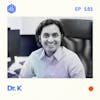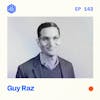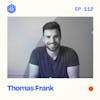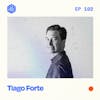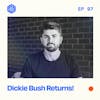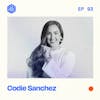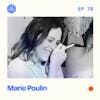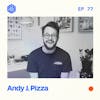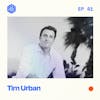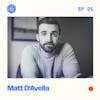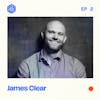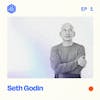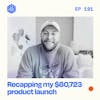
What went well, what I’d change, and what remains to be seen with the launch of CreatorHQ.
Earlier this month, I launched a brand new product called CreatorHQ. The way I’ve come to describe CreatorHQ is a complete operating system for creators – it’s literally the system I’ve built for myself in Notion to run the entire Creator Science business.
I use CreatorHQ every day. It houses all my goals, projects, tasks, content, CRM, sponsorship campaigns – everything! This episode was prepared in CreatorHQ. It’s the glue that keeps my business together and keeps the trains running. And I knew if I made it available for other creators, it’d help you too.
So I launched this on April 11 and had some bonuses available for those who purchased before April 15. It was my first true LAUNCH of something, and I put a lot of time and effort into it. Between April 11 and April 15, CreatorHQ generated $60,723.
In this episode you'll learn
- About my launch strategy
- The good things I'd do again
- The bad things I'd do differently
- And a few things that I'm still indifferent about
Full transcript and show notes
Get CreatorHQ (use promo code PODCAST)
Episode #184 with Amy Porterfield
***
RECOMMENDED NEXT EPISODE
***
CONNECT
📫 Get my Professional Creator Crash Course (free)
🧰 Get my full gear list (free)
🙏 Make a guest or mailbag request
📝 Check out our curated Playlists
***
SPONSORS
💼 View all sponsors and offers
***
SAY THANKS
💜 Leave a review on Apple Podcasts
Learn more about your ad choices. Visit megaphone.fm/adchoices
ay Clouse [00:00:14]:
Hello. Welcome back to another episode of Creator Science. Just you and I here today, just the 2 of us chatting it up. I wanted to do a little bit of a retrospective, a breakdown on my recent product launch. Now, earlier this month, I launched a brand new product called Creator HQ. The way that I've come to describe Creator HQ is a complete operating system for creators. It's literally the system that I've built for myself and Notion to run the entire creator science business. It's what I use to collaborate with my wife, with my team.
Jay Clouse [00:00:47]:
Everything that we do is inside of Notion. In some ways, I've been building this system for literally, like, 3 years. And in other ways, I've been polishing this public facing version of Creator HQ just since the beginning of 2024. But I use Creator HQ every single day. It houses all my goals, my projects, my tasks, all the content that I create, my CRM, my sponsorship campaigns, everything. This episode right here was prepared in Creator HQ. It's the glue that keeps my business together, and it keeps the trains running on time. And I knew if I made it available for other creators, it would help you too.
Jay Clouse [00:01:26]:
So I made it. I launched it on April 11th and had some bonuses available for those who purchased before April 15th, So it was a 4 day launch window. It was my first true launch of something. I've, of course, made things and sold them before, but I've never really done like an open and closed launch like this. So I put a lot of time and effort into it. Now, between April 11th 15th, Creator HQ generated $60,723. It's still available for sale now. It's not going away, and it's generated an additional $8,000 since going on Evergreen.
Jay Clouse [00:02:04]:
So in total, as of the recording of this episode, Creator HQ has sold $68,734 in the month of April. So in this episode, I wanted to break down the launch strategy to show you what I did, the good things that I would do again, the bad things I would do differently, and a few things that I'm sort of still indifferent about. Jury is still out. I'm still on the fence. But I think you will learn a lot from this and we'll get right into it after this. Alright. Let's dive in. Let's start with the statistics again just to give you some numbers and and some context.
Jay Clouse [00:02:41]:
I'm gonna break down the sales by day during that 4 day launch window, but I just did the math on these, and they actually add up to, like, $62,000. And my initial math showed a $61,000 for the launch. And that's mostly due to the fact that Lemon Squeezy is using like UTC time zones. So some of the purchases that came in on Sunday, for instance, actually got counted as a Monday purchase. Anyway, give me a little grace on the math, but the launch itself, $60,723 during that 4 day window. And here's the rough breakdown. It launched on a Thursday, and that Thursday, we did $16,116 and Friday was a little bit less than half of that at 7,211. Saturday was about half of Thursday at 8,059 and then Sunday, the day before the bonuses went away, we generated $31,065.
Jay Clouse [00:03:42]:
So that's a huge, huge difference day to day. You know, the launch day, 16,000. The day before bonuses go away, 32,000. And then the 2 days in between almost added up to Thursday between the 2 of them. So what you see here is like a very u shaped progression where you have an initial bit of excitement around the day of launch, then things are a little bit slower between the 1st day and the last day, and then the last day of launch, things went a little bit crazy, which people have told me for a long time. For years, I've heard about launches and that this is kind of the way that it goes. But it it still feels weird and scary if you feel like you're tracking under what you're trying to do and then weird when you just see how much activity is suddenly happening all at once. So that's the stats.
Jay Clouse [00:04:30]:
That is a total of 286 sales. 286 people purchased Creator HQ during this time. A 113 of those people, I can identify as having been on the wait list. I'll talk about my wait list strategy here in a second. 18 of those people came from listening to this podcast. So if you're one of those, thank you. I see you. 10 emails were sent during this campaign.
Jay Clouse [00:04:55]:
3 of them went to the whole list, and 7 of them went to just the wait list. There were 2 affiliates who sent a dedicated affiliate broadcast on behalf of Creator HQ. That was Chanel of Growth in Reverse and Justin Moore. So thank you guys. I put out a total of 18 tweets during this launch window that were related to Creator HQ, 5 LinkedIn posts, 1 Instagram story, and 1 Instagram post. So that's the numbers. That's the baseline and things that I wanted to share so that you can, as I'm talking through the strategy and things, kind of normalize your own launches. Maybe you've sent fewer emails.
Jay Clouse [00:05:31]:
Maybe you've sent more. I can tell you that sending that many emails was uncomfortable for me, but, ultimately, I'm glad that I did. I did not utilize Instagram as much as I could have. I've been putting a lot more effort into Instagram over there. My wife is helping me with some reels and just making things look better. But Instagram, I think is a big, big, big opportunity that I've historically put zero time or effort into and try to do more there. But to post one story and one post during that launch window, not very good. And actually, it was effective.
Jay Clouse [00:06:01]:
Those stories were effective. Like what I had done on Instagram and that story would say, hey, by the way, I'm doing this launch. It's about this tool, this operating system. If you have any questions, put them here. And I use, like, the the question sticker. Is that what it's called? And people ask questions and I shared their questions and answered them on my story. So it was effective because I did see a couple of people have conversations with me in the DMs, and then they went to purchase the product. So I feel like I could have done, like, 3 or 4 x that effort on Instagram, and it probably would have been good.
Jay Clouse [00:06:34]:
Okay. Additional added context that I think is important to share upfront and acknowledge because a lot of times we see these stories of, like, how I did a $200,000 launch, and they they give the steps. But really, the the answer is you had a huge audience. So I wanted to share how big my audience is on these different platforms. So, again, you can you can calibrate your expectations to your own launches a little bit. So when I launched this, I had 58,000 total email subscribers and there are about 24, 25100 people on the wait list who over the course of a month or so told me they were interested in learning more about Creator HQ. They're about 45,000 followers on Twitter, but, you know, who knows how many of those people I'm reaching on a regular basis and about 40,000 followers on LinkedIn. And I would say those are the 2 platforms that I really was engaging with the most during the launch in terms of social.
Jay Clouse [00:07:25]:
Instagram was about 7,000 followers. So those are the bits of necessary context that I thought I would share with you here. Of course, we have the podcast here, and the podcast reaches about 5,000 people per episode. And we had 18 people purchase using the promo code podcast, which was an exploding short term code and an exploding episode, which we'll talk about here in a second as well. But first, let's start with the good things, the things that I would repeat if I was doing this all over again. One good thing that I obviously want to acknowledge is I feel like this was a successful launch. I'm very happy with the outcome. It was a slow start, so I'll talk about the emotional roller coaster that I went through and how I would do things differently to avoid that emotional roller coaster if I did this again.
Jay Clouse [00:08:13]:
But when I look objectively, especially when I consider the full month of revenue, which is just shy of $69,000 now, that launch was 50% higher. The launch was 50% more revenue than all time sales of my best selling course, Build A Beloved membership. So that's huge. It also tells me that I don't do a good enough job selling that course, but Build A Beloved membership has done somewhere around $45,000 in revenue all time, and this launch did more than Build A Beloved membership has sold all time and 3 times more revenue than both Podcasts Like The Pros, my podcasting course, and the newsletter masterclass that has sold a ton of units. It's a lower priced course. It's about $99 for that one. So it's driven a ton of units, but this had 3 x the total revenue of those courses. And the reason I'm bringing this up is my business has been pretty dependent on the lab, our membership in terms of revenue for the last couple of years.
Jay Clouse [00:09:13]:
I shouldn't say dependent, but it's been the biggest driver of revenue has been that membership. And what I've been trying to do is build assets and systems to earn more money from digital product sales than the membership and it's been a slow difficult climb and the biggest challenge has been I haven't had a good digital product that serves the typical audience member of Creator Science and Creator HQ is the thing that I believe will make that difference. And I'm very, very pleased to have this now in the stack because I think this will help us turn digital products into one of our highest percentages of revenue drivers in the business. So that's the first good thing. That's the thing I want to acknowledge right up front. I'm also very happy with the name that I chose. So this was non trivial. It took some time, a lot of collaboration with my wife to figure out what is the best name for this thing.
Jay Clouse [00:10:09]:
We looked at some other stuff, like I looked at creator brain, which I thought was good. Spoke to the 2nd brain thing, but almost, like, piggybacked on the 2nd brain name too much. There are other people who created something like creator brain. I really wanted something in the name that felt like a core piece or, like, the central place where something happened. So I liked HQ in it. I'm also very happy that it has a nice acronym. Like, I can just say CHQ as shorthand, both audibly here on the show, in conversations in the community, in text or writing and emails. So I'm very happy with the name and the acronym attached to it.
Jay Clouse [00:10:48]:
I used Lemon Squeezy as a payment processor for this for the first time. I've been increasingly nervous, I guess, thinking about tax implications on Stripe. There's something called a Merchant of Record, which Lemon Squeezy is, Stripe is not. A Merchant of Record basically makes tax compliance easier for the individual. It comes at a cost. Lemon Squeezy has a 5% transaction fee right up top, and Stripe is 2.9% plus 30¢, and Lemon Squeezy has other fees involved too. So it's it's more expensive to use Lemon Squeezy on a per transaction basis, but they are a merchant of record. It handles tax compliance.
Jay Clouse [00:11:32]:
It handles things like invoices and VAT for European customers. So I wanted to try it out because I saw a lot of people who were in, like, the Notion space and selling digital products. They were moving to lemon squeezy and had good things to say, and I've had a really great experience, to be honest. The interface is, like, really easy to use. It's pretty delightful to set things up. They have some built in functionality that I'm very, very happy with. One of them is affiliates, So it has affiliates built right in, makes that easy for people to join your affiliate program and share your product. It also has abandoned cart emails built right in, and those things have their own, like, associated costs, but it's all a percentage of revenue, and it's very easy to get set up.
Jay Clouse [00:12:20]:
So I'm very pleased with Lemon Squeezy. There are some aspects that I don't love. In particular, their payout schedule. They pay out twice a month. So that launch ended on April 15th. I literally just got the payout for that or the 1st payout for that on Saturday 27th. They do payouts twice per month on 28th 14th, and it's not great for cash flow, but it's also not bad. You know, getting paid out every 2 weeks, really not that bad all things considered.
Jay Clouse [00:12:51]:
So I mentioned the abandoned cart emails as part of Lemon Squeezy, and I did some research into our data here. And abandoned cart emails accounted for $1,753 in sales. So I think that's really, really positive. I actually had some testing done on the abandoned cart emails before launch, and I think Lemon Squeezy had or has a bug in this because there were people who actually purchased the course who still got abandoned cart emails. And lemon squeezy is supposed to send 3 emails over the course of some period of time. But, like, even in my own testing, I saw that I got those I got 3 consecutive abandoned cart emails like the same day. So I think there's some bug there. It's kind of weird If it was coming from my email provider, I would expect that some people would unsubscribe, but since it's coming from Lemon Squeezy, I felt like well, let it ride and see what happens.
Jay Clouse [00:13:49]:
And to generate almost $2,000 in additional sales for a, you know, a $300 product, we're talking oh my gosh. Public math. Not the best idea here, Jay. Divided by 297. So we had about 6 additional sales that came from abandoned cart emails, and so that's that's worthwhile. Looking at affiliates as well, I said that's built into lemon squeezy, which it is. Affiliates generated top line $4,336 in revenue that pays out $867 to the affiliates, which means that I grossed $3,469 from affiliates, which is great. I feel like this is something that I have not done well in other products.
Jay Clouse [00:14:34]:
Well, in the lab. In the lab, we've definitely generated tens of 1,000 of dollars in affiliate referrals, But for digital products, I haven't seen this type of volume before, so I'm very pleased with it. Very easy for people to get signed up, and I had built into Creator HQ itself a task to become an affiliate. I make it very easy to learn how to become 1 and to encourage people to do it. So I think that's gonna be really good long term for the product. Something I did in the lead up to Creator HQ before I began the marketing strategy, which I'll talk about here in a second, was that I let members of the lab test and use Creator HQ early and at no additional fee. And that's that's a standard part of membership. Now, if you join the lab as a standard or VIP member, you will get access to Creator HQ as part of your membership.
Jay Clouse [00:15:24]:
So I got people in there early testing things, giving me feedback in the community. So I was finding bugs and fixing things and adding things and making it better before I went out publicly. And because I shared it with folks in the lab 2 plus weeks before the launch, people had a chance to use it and I was able to get testimonials from them, which I think is huge to get testimonials from people on a product so that when you do the public launch, you already have a ton of social proof of people who have used it and had a result. I think that's really really important. So I'm very very glad that I let members of the community have that for free. That's just part of why I love having a membership. When I make new things, I can give it to the members for free and get really great feedback on top of it. It's a win win win all around.
Jay Clouse [00:16:08]:
So I'm I'm just glad that I did that. Members of the lab aren't the only people I got testimonials from ahead of time either. Something that I noticed when Justin Welch did his launch for his big course creator MBA, he sent out an email to a bunch of people, myself included, asking for a testimonial. And I wanna read you his email and then I'll read well, I'll read the email that I sent out that was inspired by his email. We'll do that. The subject line was small favor question mark and I sent this out to people who I am friends with, who I know well, who I also know have some sort of public profile and I basically asked them to give me like a character testimonial. I offered to let them use the product if they wanted to to give a testimony on the product itself, but I just asked if you don't have time, no worries. Do you have time to give like a character testimonial for me so that I can put that on the sales page? Because that's social proof about me and my ability to make something worth purchasing even if it's not a direct testimonial for the product itself.
Jay Clouse [00:17:13]:
So here's the email that I sent out to folks. The subject line said small favor. It says, hey, and then their name. I hope you're having a great week. I had a small favor I wanted to run by you. I'm getting ready to launch a new digital products called Creator HQ. It's a literally a templatized version of my own Notion setup, the one that I've been building and using to run Creator Science. I've even combined the template with a ton of video tutorials on how to use it so that implementation is easy.
Jay Clouse [00:17:39]:
If you're curious, here's an overview, and I linked that. I've shared it with members of the lab this last week, and so far, the feedback is glowing. And then I linked to testimonials from people who had used the product. I'm looking to feature some testimonials from creators like you on the landing page, not a testimonial for the product itself necessarily. You haven't used it. You may not want it, but basically a character testimonial about why I'm the right person to put something like this together. And I put that in bold. Why I'm the right person to put something like this together.
Jay Clouse [00:18:07]:
2 short sentences would be plenty. Would you be open to that? I admire you and having your with me a lot, but there is no pressure and no expectation. Thanks for the consideration. And if there's anything I can do to support you, please let me know. So I sent that request out to, like, 15 or so people, and, universally, people were very positive, very supportive. Almost everybody that I sent an email to responded. Only one person declined, and I think it had a meaningful impact overall on the strength of the sales page. So I'm very, very glad that I did that.
Jay Clouse [00:18:43]:
And if you're gonna launch something, I would recommend you do the same, Getting testimonials from early users, but also testimonials from people who know you, who respect you, who want you to win, and who other people might recognize as well. Alright. I'm gonna catch my breath. I'm gonna get a drink of water, and I'm gonna break down my full wait list strategy, which I think is probably the most important part of this whole thing after a quick break. Alright. We are back. Let's talk about this wait list strategy that I put in place. So I am somebody who typically and historically has just done presales, and what I would do is I would have the idea for, like, a course, like my Build A Beloved membership course, and I would build a shell of the sales page ahead of time so I can show exactly what I'm going to teach and more or less what's going to be inside of the course.
Jay Clouse [00:19:33]:
And then I'll let people know this is on presale. If enough people purchase it on presale, I will develop the course and deliver it by this date. And as an incentive, I will presale the course at usually a discounted price so that I'm recognizing and appreciating people who are early supporters the most. And this has done okay in the past, but not great. Not as well as this launch has done. So what I wanted to do was build anticipation with this launch in a way that wasn't just a pre presale. And this is something that I picked up from Kieran Drew. He was on an episode of this podcast.
Jay Clouse [00:20:09]:
It was episode number 158. And he talked about how he built anticipation for his launch of his course, High Impact Writing. I was also thinking about the conversation I had with Chris Williamson when he talked about building anticipation for his podcast episodes, I realized that the key to a good launch is stretching out anticipation, almost like stretching out a rubber band so that when you launch it when you let go of the rubber band, it has this big reaction and sends waves and people are already aware of it. They're ready to purchase it if they're interested in it as opposed to making a thing, launching it, and then having to educate people on the thing at the same time that you're trying to sell it to them. So anticipation basically takes the education and marketing effort and front loads it before there's even the opportunity to buy it. So that when the opportunity to buy does happen, people have already made a yes or no decision. So let's talk about how I did that over time. I ended up pushing back the launch of this more than a month later than I typically would have.
Jay Clouse [00:21:14]:
Told you about the episode that we had on the show with Kieran. He also came into the lab and did a private session for members of the lab to talk about his second launch, and we talked live on that call about my launch. We basically, like, brainstormed how I could best go about it. And he encouraged me to put it off till a little bit later. I have the strategy that included some bonuses. A lot of what I did in that launch, I actually took from Kieran's advice in that call. So I pushed the launch back. I use ConvertKit as my email service provider, and I recommend if you're using emails that you consider ConvertKit as well.
Jay Clouse [00:21:48]:
But one great thing about ConvertKit is this thing called link triggers and tags. So what I did, it was for months before the lead up to this, at least weeks, but I think actually for a couple of months before Creator HQ was launched, whenever I talked about it, I would end that section by saying this is going to launch on this date April 11th and if you want to be one of the first to know, click here And I would link that text that click here text to what is called a link trigger in ConvertKit. That is just basically a little bit of logic to say when somebody clicks this, ConvertKit will automatically add a specific tag to that person's record inside of ConvertKit. And that tag that I used was called interest hyphen creator HQ. So for months, I would talk about creator HQ, get people excited about it, show them what it could do, and then say, if you wanna be the first to know about it, click here, and they would basically opt in to this tag that said I'm interested in learning more about Creator HQ. And over the course of like 2 months before the launch, about 2,400 people did that. Like a large number of people had learned about it and had clicked a link to learn more about it. And so for the last, like, 4 weeks leading up to launch, every email I sent had a paragraph at the top of the email that spoke directly to the people who had already said I'm interested in Creator HQ, told them more about it, got them more interested.
Jay Clouse [00:23:11]:
And the people who hadn't yet said I'm interested, it gave a different bit of copy to try and get them interested, try to get them on the waitlist. This is something called liquid coding in ConvertKit. It's like this coding language that basically lets you say, hey, if the receiver of this email has this tag, display this text to them. If not, display this other text to them. And so you can personalize the message to the receiver based on whether or not they were on the waitlist. So this process got 24 100 people on the waitlist and got the waitlist people interested in the launch. So that was super, super important because not only did I do that in email, but I had, like, a preview video that I made, and I made a ConvertKit landing page to show the preview video. And if people opted into that form, they were also put on the wait list with that tag.
Jay Clouse [00:24:05]:
So that effort for weeks, I think, was the most important part of the overall launch. And as I told you at the beginning, I sent 10 total emails during this campaign, but 7 of those 10 emails went just to the wait list. It went just this 2,400 people out of the 58,000 that were on the total list. And the total sales, half of them came from the wait list. And, you know, 2,400 divided by 58,000. That's 4% of people on my list were on the wait list, but 50% of sales came from the waitlist. So I was able to avoid hitting people with too many emails on the main list and get my most interested, warmest leads enough information to make a purchasing decision. As As I'm sitting here recording this, I just got a notification in Slack that somebody just purchased Creator HQ, and it's just like the most magical amazing thing.
Jay Clouse [00:25:01]:
I put a ton of time and effort into this, made something that I really believe in. I know it's helping people because I'm getting incredible feedback, and I don't know who that person is that just purchased, but I think they're gonna have a great experience. And I didn't have to do anything to deliver that good experience outside of what I have already done. Digital products are an amazing thing. I just I would love if this continues to grow and become one of the biggest parts of the business revenue overall because it would just add so much stability and optionality to the business. So, man, I'm just I'm just super excited about this. Anyway, that was the waitlist strategy. Now I wanna talk about the launch window with bonuses.
Jay Clouse [00:25:40]:
As I said, I've never done like a launch window before and I've always had a little bit of disdain for, like, launch windows because if you're making, like, faux urgency for no reason, I just don't love it. It just doesn't feel great. But it also feels like something you kind of have to do in this launch model. So the in between that I found was to offer a few launch bonuses during this window and basically say, like, this 4 day period during this launch is the only time you're getting these bonuses. And so those bonuses were 1, my newsletter master class. That's a $99 value. I just wrap that in to the experience. 2nd bonus was a live onboarding session.
Jay Clouse [00:26:23]:
People who purchased during this 4 day window were able to join a live Zoom session where I walk people through the onboarding to make sure that they got this into their account and they're comfortable with it, and then walked through how I use Creator HQ and then took some questions from the audience to show them specific use cases of how to do this thing in Creator HQ, and we had, gosh, 60 plus people on this call live and I recorded that and now that's part of Creator HQ 2. It's part of the tutorials. You can watch that live onboarding recorded inside of it now. So that was bonus number 2. And then bonus number 3, people who purchased were entered in to a drawing and I randomly selected 2 people to give them a 30 minute 1 on 1 coaching session with me. And that bonus, I didn't actually roll out until the 2nd day of sales, which I think is interesting and was useful. Basically, to add bonuses throughout the 4 day window, sweeten the pot, and got the people who were still on the fence off the fence. So I did like that strategy.
Jay Clouse [00:27:28]:
I think in the future, I would double down on more bonuses thinking about how to make them really really awesome, really additive, and then even think through when I introduce them in the marketing campaign. Because, you know, basically, if I sent 10 emails during a 4 day period, I was sending 1 email in the morning, one email at night, That was kind of the cadence. So you can think through that and say, okay, if I'm sending 2 emails a day, when do I introduce new bonuses so that I can maximize talking about those bonuses, but also gives people a reason to continue to open the emails and read about the product? So that was really, really positive, the bonuses. With this launch, because I knew I really wanted people to see just how powerful the tool was, I wanted to record an overview video to show people what was inside of it, but this became uniquely tricky. And actually, we're making, like, a shorter, highly produced sizzle video right now, but it was really tricky to make a video about this because it's easy to screen capture. I can screen capture and show you how to use this. But because there is so much in it, that video can be kind of long. So it was like, how do I keep this short, but also show people the depth of what is here? It took a bunch of takes, like, it took a lot of tries, actually.
Jay Clouse [00:28:48]:
It got kind of frustrating. I made a list and said, okay, what would be on the sizzle reel of what I really need to show about this tool to get people excited about it? And then I I tried again and again and again, and then I had to edit that video and insert things because I forgot to talk about a certain part of what was on screen. So I made this video and it ended up being like 12 minutes long, and it's like a dense 12 minutes. You see a lot in 12 minutes. It's still the main video on the sales page at creatorhq.co so you can watch it. But that 12 minute video, I knew it would be good for the sales page. What I didn't really think about, but turned out to be a stroke of, like, brilliance was I shared that video on Twitter and LinkedIn the mornings of the launch. And I shared it natively.
Jay Clouse [00:29:32]:
I didn't like share a YouTube link. I uploaded the video natively to Twitter and then uploaded the video natively to LinkedIn and said, hey, Creator HQ is live. Here is what it is. Here's a video of it. And because that video is long, the people who took time to watch it sent, I believe, a really positive signal to the algorithms on those platforms that this is engaging content. People are spending a lot of dwell time on this. And so those those posts, the launch announcement on Twitter and the launch announcement on LinkedIn, they both outperformed my typical posts by a lot. Like, to have a sales post essentially outperform your typical content is like a dream.
Jay Clouse [00:30:12]:
It's awesome, and it performed well enough on Twitter that now I I pinned that tweet to my profile. So new people who discover me on Twitter, they're going to see the Twitter shopping link that says Creator HQ. They're gonna see a pinned tweet about Creator HQ. So the work I do of getting in front of people on Twitter is already introducing them to the product. And so, yeah, using an announcement video on social media, highly recommend. I think it's probably gonna work well for you too. But again, it has to be, like, tight. It has to be engaging.
Jay Clouse [00:30:47]:
So take the extra time to make sure that is true, but it can make your announcement post perform pretty well. So that's what I did on social media. I obviously emailed the wait list the morning of and said this is available. Here are the bonuses. Here's the promo code because people on the wait list got a 10% discount as a thank you for raising their hand early and saying, I want to know about this. Similarly, I published a I think it was like an 8 and a half minute audio episode of the podcast. So it's episode 190. You may look at your podcast player and say what happened episode 190? Well, episode 190 was about the launch of Creator HQ.
Jay Clouse [00:31:24]:
We talked about the product and I made a discount code available, a 10% discount code for listeners of the podcast, and it was a different discount code. This is important actually. I wanted to see what type of activity would happen from the podcast itself. So the discount code for the waitlist was different than the discount code for the podcast listeners, And I said in that podcast episode that this episode will only exist until Monday. Monday was the end of the sale. So the people who do listen to the podcast shortly after it's released heard about that. They got a discount. They were able to redeem that and that is how I know how many people came from the podcast.
Jay Clouse [00:32:03]:
I wanted to have separate codes so I could see who came from where, so I can understand the efficacy of the podcast, for example. So I got really really excited when I saw people purchasing using the podcast promo code because it's so hard to know who's listening, who's out there, who's listening to this right now. I have no idea. It's very very hard to tell, but I'm glad that I did the promo episode. I was gonna do like just an ad that I would play throughout the back catalog for a couple of days, But then I realized that wouldn't kind of create like a notification of the launch. It would just kind of slot into people's regular listening, which maybe they don't listen during those 4 days. So I do think I will probably create a internal ad for Creator HQ for the podcast here, maybe even this week and start playing it across the back catalog. But I liked having a dedicated episode that basically exploded after a few days, you know, saying this will self destruct on Monday.
Jay Clouse [00:32:58]:
I thought that was effective. Something I didn't set up initially, but quickly did get set up was purchasing power parity pricing, PPP pricing. Basically, this is not a strategy, but a decision to say if you are in a country that does not have the purchasing power of the US dollar, I will create a discount code to make the price the effective same price in your home country, in your home currency. So there is a tool that makes this pretty easy called Parity Deals.paritydealsdot com, and what I used them for was that they made suggestions for purchasing Power Parity pricing based on countries. So when someone wrote from Bangladesh and said, I'm interested in this, but I can't afford it, I was able to look at parity deals and say, okay, what would be the effective price for somebody in Bangladesh or Hungary? And I made promo codes for that, and actually parity deals will make promo codes for that for you as well. And if you want to go so far as to embed JavaScript on your website, they can display those codes automatically. I did not go that far because you do run the risk when you use tools like this of like VPNs and abuse where people who do not need parity pricing will use a VPN to say they're in a country that would get parity pricing and then just get a cheaper price. So I'm a little wary of that.
Jay Clouse [00:34:23]:
So what I did was I added a FAQ section to say, do you support PPP pricing? And I said, if you can't afford this and you're in the 3rd world country, email me. Let me know what country you're in, and we'll get back to you. So I did have a handful of people purchase in different countries, and I feel good about that making things accessible. I don't know if I would go so far as to put the JavaScript on my website. One, that would put me into a paid pricing tier on, parody deals, but it'd be worth it because, again, this is like found revenue. But I I like the system of basically asking people to self select and raise their hand and using that to fight abuse. So I I like PPP pricing. PPPP, essentially.
Jay Clouse [00:35:07]:
I like it. I think it's a good strategy. I was glad that I did the live onboarding session. It was a bonus, but also I think it's a really good way to get people who already have initial excitement more excited about the product to get them in there and using it. Get more use cases, more outcomes, more testimonials. I did build like an onboarding sequence for folks. So after they purchase, they go through an onboarding sequence that teaches them how to use the products. So does the product itself.
Jay Clouse [00:35:33]:
It has training built in, but that live onboarding, I think helped people get over an initial hump if they needed it. And I also got to meet and see people as I'm showing people the way around it. I could see, like, their reactions on video. I could see where I was losing them. I could see where I was, like, through and blowing their minds. I got questions live so I could hear where they were stuck, what else they needed. So I got some feedback on ways to or things to add to Creator HQ. There's a link within the product to say if you have a support request or a feature request, enter it here.
Jay Clouse [00:36:06]:
That actually flows into a dashboard in my own Creator HQ Notion account, and I can see, you know, the support requests or the feature requests, and I can make it better over time. So interaction with people, creating a tight feedback loop, it's always just so valuable. And I recommend having that live onboarding or live q and a both as a bonus because people appreciated it, but it helps you as well. Alright. Two more things that went well that I wanted to cover, and then we'll get into the things that I would do differently and the things that I'm kind of indifferent about. Second to last thing that went well that I would say is I built this website in Framer. So my first time using Framer Framer is a website builder. It's like an alternative to Webflow or Squarespace.
Jay Clouse [00:36:50]:
My main website is built on Ghost. I actually just launched a new version of my main creator science.com website on Ghost yesterday. I love Ghost, but the problem with Ghost is they are a little bit rigid in what they can do from a design perspective, unless you're pretty good at coding. So I knew that I wouldn't be able to create the landing page that I wanted for Creator HQ on Ghost. So the question is, what page builder do I build it in? And to learn like an entirely new page builder, crazy thing to do, but I've heard such good things about Framer that I wanted to get up to speed. So I started with a template. I found a template from their template directory that I liked. It looked like it was actually built to showcase something in Notion, and I learned how to use Framer by customizing that template into the Creator HQ website that I wanted.
Jay Clouse [00:37:39]:
I've come to believe that Framer is just incredibly powerful and so good. I still would have a lot of a learning curve if I'm building something from scratch, but I can work from a template now and feel really good about it. The page is so fast. It's so beautiful. So happy with it. So I am going to transition my landing page for the lab from Webflow to Framer here in the next couple of months because the performance is just higher. It looks better. It feels better.
Jay Clouse [00:38:05]:
I am full Framer over Webflow. Alright. And last thing that went positively that I would absolutely double down on. I was out for a run when I was listening to my friend Jeremy and Justin's podcast Podcast Marketing Trends Explained is the name of the podcast. And Jeremy was talking about running a survey asking people why they didn't buy something if they did not buy something. And this was just a couple of days after the end of the launch. So I put together a quick survey. I asked the waitlist why they did not buy if they did not buy, and I got incredible feedback.
Jay Clouse [00:38:43]:
So I asked just a couple of questions and I'll share them with you here. I asked why did you decide Creator HQ wasn't for you and it was multiple choice. There's things like bad timing, price or budget. I don't use Notion. I miss the deadline. I'm too early in my journey. I didn't understand what it does. I already have my own operating system and other.
Jay Clouse [00:39:04]:
And then if people asked or answered price and budget, I asked the follow-up question of what price would have felt like a bargain, and then what price would have felt like a stretch but might have been worth it. So this tells me how much people value the product based on what they know about it. This is not telling me this is the price that it should be. I could I mean, I could say here's how people value the product based on what they know and just go with the average of the prices people gave me. But actually what I was trying to do was say I believe in the price of this product and I think it's worth it. But I wanted to see how far off I was in terms of perception for what people thought the product was worth. So incredible feedback there. Most people said price.
Jay Clouse [00:39:48]:
Outside of that, it was I already have my own operating system or I don't use Notion. So that was kind of a nonstarter for those people, but super insightful. I had a optional fill in the blank question of how would you describe your reason if they answered other or is there anything else to add if they didn't answer that? And, man, people were so generous with what they answered. So insightful, so helpful. So really, really recommend doing the why did you not buy strategy. Alright. That's all the good things. So next, I'm gonna get into the things that I would do differently if I was doing this again and the things that I'm indifferent to, which we'll jump into after one last break for our sponsors.
Jay Clouse [00:40:32]:
And we're back. So what would I do differently if I was doing this again? And I will say I do think that I did a good job here. And that's hard for me to say because I am not generally someone who celebrates the the wins and focuses on the positive. But I do believe that this was net a very positive experience and I did a good job. But there are some things that I would do differently or will do differently in the second launch. Maybe you don't have to look at this and say, I have to do all of these things right on the first launch of my product. No. But here are some things that I would add or I would do a little bit differently.
Jay Clouse [00:41:05]:
Starting with, I was kind of a miserable person to be around for the week or 2 leading up to the launch of this, and I think I really stressed my wife out because I had all of these questions and anxieties of would people buy, would people care, was this effort worth it at all. I had this, like, gnawing fear about the price because this is priced higher than most Notion based products, but I also knew it was better and more comprehensive than most Notion based products, while still being intuitive and easy to use. So I knew that the price was worth it. I just wondered had I done enough to create the perception that it was worth it to someone who hadn't seen it yet. And it resulted in a lot of me being stressed out and doing more and more and adding to sales page and working late. And I think I I made home life, the Klaushold, a little bit stressed and anxious and I would I would like to not do that the next time. Second thing, I didn't have a banner on my website when I launched this. So this is on a dedicated domain.
Jay Clouse [00:42:11]:
It was creatorhq.co. I have lots of traffic that goes every day to creatorscience.com. So when I launched this and I told people about it in email and podcasting, I gave them the direct link to creatorhq.co so the people who knew about it would be on the right page. But the people didn't know about it, I didn't really give them a pathway there for a while. So after, you know, half a day, I realized this and I added a little banner to my main websites to say, hey, just launched creator HQ, complete operating system for creators, learn more over here, and it directed them to that website. I used the term Notion template initially, and that was a bad idea. Just a bad time because people the term Notion template has so many built in assumptions that are primarily based around pricing. People buy Notion templates, pop them like candy, and then don't use them.
Jay Clouse [00:43:09]:
And I'm looking at this. I'm like, this is a Notion system. This is a comprehensive operating system that happens to be built in Notion. But when you use the word Notion and a template in an email, people will look at it from a pricing perspective of other Notion templates. And I should not have done that because the people who had a price sensitivity, that is half of the issue, was that I said Notion templates. So I tried to avoid using the term operating system even though I knew it was right just because I feel like it's overused in the space. People calling everything an OS. You have an OS for everything.
Jay Clouse [00:43:44]:
You got a newsletter OS, and you got podcast OS, and all those are great products. But, like, operating system is becoming overused, and I wanted to not add to that noise, but, unfortunately, I didn't have a better term. So now I am calling it, in fact, an operating system for creators. And the second part of why I think pricing was an issue, something that would change, is I would have talked about the price sooner. I didn't talk about the price until the sales page was live because I didn't wanna talk about the price until people could watch the video because I was worried that people would hear the price, assume what a Notion template is, and say 297 is too high for that product. So I thought, well, if I can show them the video and show them on the sales page what this thing can do, 297 will feel like a bargain. And I just didn't have all that done until, like, a day or 2 before the product launch. So I didn't talk about the price until literally I sent the email saying here it is and I didn't even put the price in the email.
Jay Clouse [00:44:50]:
I had the price on the sales page. So I had somebody email me and say, hey, psychologically, if you don't tell me the price, I'm going to think that it's overpriced. And I think they're right. You know, in the past, I've always put even on the button in the email. If I say like, Hey, go get this thing. I'll put the price on the button. And I should have done that earlier in the campaign when I was even warming up the wait list. I should have told the wait list this is the price of it, but I didn't have enough to show, and I was calling it a Notion template.
Jay Clouse [00:45:20]:
So I think I was right to worry that the term Notion template would have people undervalue the product, but I think I was wrong in not sharing the price earlier so that people could mentally prepare for it. There was no sticker shock at launch. I think part of the reason half of the sales came on the last day was people had to spend 4 days considering the price, and I I just wish I would have laid that out ahead of time. Justin Welch did that really well in his launch of Creator MBA. He showed the price real, real early, and I thought to myself, mhmm, that's pretty brave because it was a high price. But I think it was the right move, and I will do that differently the next time. Let's see. Other things I would do differently, I think I underprepared my affiliates.
Jay Clouse [00:46:02]:
I actually put together a a good amount of resources for them. But again, I didn't put those resources together until 3 days before the launch. So not really enough warning to give people to plan an affiliate strategy on your behalf. But it did have some people who were in the lab, Chanel and Justin, who created dedicated newsletter blasts for it. They got some sales. They're getting paid for that. I appreciate them. I owe them one.
Jay Clouse [00:46:29]:
And in the future, I will try to get affiliates around earlier. I actually have some big joint campaigns coming up with a couple of partners who want to do an affiliate campaign, a big affiliate launch later in June. So I'm gonna put together more resources. I just wish I would have gotten a little bit more ahead of it. But again, first time launch this product, maybe you don't need affiliates. Maybe affiliates, there's, like, a second or a third time thing for your launch. So I felt like I I underperformed there, but again, it's, like, more than I've ever done in affiliate revenue. So I have to temper my expectations a little bit.
Jay Clouse [00:47:07]:
I told you that I reached out to about 15 people for, like, character testimonials early on people who I think respect me and wanna see me win. There was another list of, like, 12 that I didn't reach out to because I chickened out. I was too scared. I just didn't feel like we had a good enough relationship or I didn't want to call in a favor or I was just too scared to ask some bigger names for help. And the worst thing they could have said was no. So I wish I wasn't a chicken. And, you know, next time maybe I'll go to them when I have more evidence. But, you know, if you have a list of people that you wanna reach out to who you think would say yes, and you don't reach out to them, that is you getting in your own way.
Jay Clouse [00:47:47]:
So do not do that. Get out of your own way. I talked about this a little bit already, but I think I would focus on I focus even more on bonuses during the launch window, making them really, really compelling, making them differentiated. Because the problem I'm gonna run into, if I did this again and I did the same bonuses and I said, you can get the newsletter masterclass for free, a lot of people have already purchased the newsletter masterclass. So really what I need is like net new material that people would find valuable as opposed to something that wouldn't be an incentive for somebody who already has it. And this is a worthwhile thing to think about anyway because I'm thinking about revamping my newsletter referral program. And to do that, I'm also thinking I need net new assets, things that you can only get in this means, making it scarce by saying you can only get this asset as a bonus with Creator HQ or you can only get this asset as a bonus for referring 3 subscribers. Creating those high value assets that you can only get access to through this means makes for a really compelling incentive.
Jay Clouse [00:48:54]:
So think about that for your own stuff as well. And lastly, something that went poorly or something I've learned a lesson from, I guess, with the wait list folks, I gave them a 10% discount during this launch window, and I felt so proud of myself because I figured out how to create a direct discount link in lemon squeezy. Like you click this link, automatically applies the discount. So I told people, hey, your discount brings the price down to 267. Click here to use that discount code instead of making them remember the code and entering it themselves. But the problem is when you go straight to the checkout with a discount code, you skip the sales page, you skip the video, you skip all of the context as to why this product is awesome and why it's going to change your workflow. So I think the people who did click on the discount link directly didn't have the same experience or the same intent to purchase, and that's my fault. By giving them that shortcut, it didn't allow them to learn about the product and build some desire for it.
Jay Clouse [00:50:01]:
Now let's close out on a few things that I'm indifferent about with this launch, meaning I did them, but I don't have any evidence to say this is worth it or definitively not worth it. Jury is still out. I'm still on the fence for these things. Number one thing was not setting a clear goal ahead of time. I did not set a revenue goal in my mind. I had like this moonshot goal that it would be cool and very marketable if I hit 6 figures on this launch, but I didn't think that was very likely. But then I didn't give myself any other goal outside of that. So as the launch happened and the first couple of days felt slow, you know, Thursday was $16,000 which is real money.
Jay Clouse [00:50:42]:
That's that's real good money. But if I had this moonshot goal of $100,000 that didn't feel like I was on the right track. And then Friday following up at $7,000 just didn't feel like I was on the right track. And because I didn't have a lower goal in my mind that would have made me happy, my experience for the 1st couple of days was disappointment, if I'm honest. My emotional response the first couple of days was some level of disappointment, and that's because I didn't have a goal in my mind of what would be good. And so I really only could peg to this huge number of 6 figures when I should have said, hey, you know what? I would be thrilled if this outperformed my best launch ever, and I would hit that on day 2. Well, alone day 3 and then day 4. So I I think I mean, different because I haven't decided, you know, on on one end, I don't wanna set, like, an arbitrary goal and then fail to hit it and then feel worse.
Jay Clouse [00:51:41]:
But I did feel like I didn't know how to feel. And so my only thing I could peg to was this huge number that I knew was very unlikely. Second thing I felt indifferent about was I submitted Creator HQ to both the Notion template marketplace as well as the lemon squeezy marketplace. I haven't seen any traction on either of them yet. For Notion, it's because it's priced higher than just about every other Notion template out there. And for Lemon Squeezy, I don't think their marketplace is actually active yet. So I did go through the hoops and put them on those marketplaces, but I haven't seen a result for them yet. So I'm indifferent to those marketing and sales strategies so far.
Jay Clouse [00:52:26]:
Creator HQ is a dedicated website. Creatorhq.co is a dedicated website as opposed to a subpage like creatorscience.com/hqorasubdomainlikehq.creatorscience.com. And I like that it's short. Creatorhq.co is nice and short and memorable. Easy to say, easy to find, and when it's on its own domain, it feels a little bit more legitimate, I think. But there are some aspects of my marketing strategy that don't work because of it. So everything else in the business is a subdomain, podcast.creatorscience.com, join.creatorscience.com. And what that allows me to do is to use RightMessage to capture questions.
Jay Clouse [00:53:10]:
If you go to createrscience.com, you'll see a toaster pop up on the bottom right from RightMessage and ask them questions about you. And based on your responses, I can make you a personalized offer and that also syncs with the ConvertKit so I know a little bit more about my subscribers. But I can't do that as effectively and follow people across different pages when I have a dedicated website. This is super nerdy. This is super in the weeds. But basically, if somebody fills out the questions on creatorhq.co and then I generate an offer for them, it needs to all happen on creatorhq.co. And then if you go to creatorscience.com, it's gonna ask you this question again because it doesn't recognize you as the same person because they're 2 different domains. So it's creating a little bit of a thorn in my side from a marketing perspective because I love having RightMessage on every page, but I do think that creatorhq.co looks a little bit better.
Jay Clouse [00:54:01]:
So I think we'll keep it as is. And the last thing that I'm I'm I call this indifferent, but maybe I should say ambivalent. Maybe this is the ambivalent, section. The last thing I'm ambivalent about is not having a refund policy for Creator HQ. I've only had one person ask for it because they said, actually my team isn't going to use Notion. And that person was already a member of the lab. And I said, you should actually should have had this for free. So I haven't had people ask for a refund, but I think when you have a refund policy, it really shows that you stand behind your product and that it gives people, like, a no risk reason to purchase.
Jay Clouse [00:54:42]:
The reason I have a no refund policy on Creator HQ is because the nature of a Notion based product is that once you duplicate it into your account, it is yours and I cannot revoke access. So it would be easy to abuse a refund policy and get the product for free if I had a refund policy, which is why I got ahead of it and put in the FAQs that I will not have a refund policy. To some people, that's like a red flag, but to me, it's just a way to prevent theft essentially. And, yeah, I'm ambivalent about it. I think it's smart to prevent theft proactively, but I also want people to have as much confidence as possible in the product and a purchase of it. So I'm ambivalent. That's the last thing. I can't believe that this was a full hour of me talking about this launch.
Jay Clouse [00:55:31]:
I did not think I had that much material here, so I hope you took something from it. I hope it's been viable and it's going to help inform your own launch. That just about covers it. I'm very pleased with the results, like I said, and we've been getting a really, really great feedback from customers so far, so I feel great about the product. If you've made it this far, which you have, I wanna let you know that I did reactivate the 10% discount code for podcast listeners. So if you go to creatorhqdot co and use the code podcast at checkout, you can save 10%. If you like this episode, I recommend you listen to my interview with Kieran Drew. That's episode number 1 58.
Jay Clouse [00:56:08]:
I also had a recent interview with Amy Porterfield. That was episode 184. Both of those episodes are about product launches. So I think those will help you. They helped me with this launch and this process. So, you know, that's a lot of where I learned things. If you enjoyed this episode, tag me on social media at jayclauss, on x, on Instagram, on LinkedIn, wherever you're at, tag me at jayclauss. Let me know that you liked it.
Jay Clouse [00:56:32]:
I enjoy doing these solo episodes, and I hope you enjoy listening to them. And if you really wanna say thank you, leave a rating on Apple Podcasts or Spotify. They really do go a long way. Thanks for listening, and I'll talk to you next week.
Most Popular Episodes
New to the show? Check out some of our most popular episodes.







